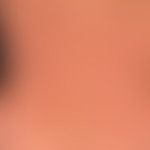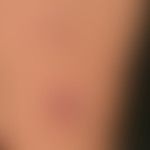Synonym(s)
HistoryThis section has been translated automatically.
DefinitionThis section has been translated automatically.
Granulomatous, autoinflammatory multisystem disease of unknown etiology characterized by the occurrence of non-caseating epithelioid cellular granulomas of the skin (and other organs - see sarcoidosis below). Sarcoidosis can affect almost any organ system, with the lungs being the most commonly affected with a 95% frequency of involvement. The skin is affected in 30% of sarcoidosis cases.
The acronym TAGU stands for "tattoo-associated granulomas with uveitis" and refers to a rare, bilateral intraocular inflammation and concomitant development of sarcoid skin reactions in tattoo areas (Carvajal Bedoya G et al. 2020).
Sarcoidosis of the skin (9-37%) should be considered an integral part of the "systemic disease of sarcoidosis" with characteristic clinical and histological changes. It can occur at any time during the disease, but it is usually present at the onset of the disease. Sarcoidosis of the skin can present with or without systemic involvement. Approximately 60% of patients with sarcoidosis of the skin also have system involvement.
Because it is externally visible, cutaneous sarcoidosis is relatively easy to confirm clinically and biopsy.
The severity of integumentary involvement is determined less by functional limitations than by disturbances in the patient's external appearance.
You might also be interested in
ClassificationThis section has been translated automatically.
Skin manifestations in sarcoidosis can be divided:
- Large nod ular form: (special form: lupus pernio).
- Small nodular disseminated form (most common form: face, extremities, trunk, mucous membranes)
- Plaque-like (discoid, annular, extensive or circine) form (clinically also appearing psoriasiform or ichthyosiform)
- Subcutaneous nodular form (13% of patients): Nodules are palpable under normal or slightly livid skin (Darier-Roussy).
- Ulcerative sarcoidosis: legs, ulcers without other clinically landmark morphology
-
Special forms:
- Löfgren's syndrome
- Cicatricial sarcoidosis (usually no systemic involvement expected)
- Angiolupoid
- Lupus pernio.
Occurrence/EpidemiologyThis section has been translated automatically.
Incidence figures vary worldwide. The incidence for Caucasians (US data) is 10-14/100,000 inhabitants/year and for Americans of African descent 35-64/100,000 inhabitants/year. Sweden: 64/100.000 inhabitants/year; UK: 20/100.000 inhabitants/year; Spain and Japan: 1,4/100.000 inhabitants/year.
EtiopathogenesisThis section has been translated automatically.
Unexplained. Familial clustering is known. There is an association with HLA-B8, HLA-DBQ1, HLA-DR3B1. The latter two HLA subtypes appear to be associated with a good prognosis. Polymorphisms of the gene coding for angiotensin-converting enzyme(ACE gene) have been detected.
Excessive T-cell-mediated immune responses to an as yet undefined agent as well as autoimmunological or infectious genesis are being discussed. Environmental toxins and microbial pathogens are blamed as trigger factors for granuloma formation (Giner T et al. 2017). Among the microbial pathogens, mycobacteria, propionibacteria and herpes simplex viruses are repeatedly suspected.
Sarcoidosis leads to activation of CD4+ helper cells of the Th1 subtype. In bronchial lavage, a shift in the lymphocyte population of the CD4/CD8 ratio in favor of CD4+ cells could be detected (CD4/CD8 > 3.5 is highly specific).
As part of this inflammatory reaction, a large number of Th1 cytokines(IL-2, interferon gamma) are produced, which on the one hand initiate the sarcoid tissue reaction and on the other hand lead to B-cell stimulation and hypergammaglobulinemia.Monocytes are attracted from the peripheral blood via the production ofmonocyte chemotactic factor(MCF).
ManifestationThis section has been translated automatically.
Young women often fall ill. But all in all ♀ = ♂. First manifestation mostly between the ages of 20 and 40, less frequently in children. Biphasic course with maxima at 25-35 and 45-65 years of age.
LocalizationThis section has been translated automatically.
Predilection sites are the face (nose, forehead, cheeks), earlobes and the sides of the extremities. The bending sides of the arms are usually left free. The lesions typically occur in cool (reduced blood circulation) skin areas and in scars, mediastinal and peripheral lymph nodes, lungs, liver, spleen, eyes, parotis. Apart from the predilection sites, there is no particular distribution pattern, but the "disordered, random" occurrence of the lesions is typical of sarcoidosis of the skin.
ClinicThis section has been translated automatically.
According to the clinical course of the disease, one separates:
- acute sarcoidosis(Löfgren's syndrome)
- subacute sarcoidosis
- chronic sarcoidosis
1. acute sarcoidosis occurs in 5% of cases It is defined by the triad: arthritis, bihilary adenopathy and erythema nodosum. The appearance of erythema nodosum often marks a benign course with a tendency to spontaneous regression within 2 years. The occurrence of erythema nodosum is always associated with considerable disturbances of the general condition.
The lung changes are divided into 3 stages according to radiological criteria:
- Stage I: biiliary lymph node enlargement
- Stage II: Parenchyma involvement
- Stage III: Fibrosis.
2.early onset sarcoidosis(EOS): Rare special form of acute sarcoidosis which manifests itself before the 5th LJ. It occurs in a triad combination with maculo-papular exanthema, arthritis and uveitis. In addition there is fatigue, anorexia, fever, hepatosplenomegaly. EOS usually occurs in isolation. A familial form is known as"blue syndrome".
3 Chronic sarcoidosis (95% of cases): relapsing episodes, usually lasting for years, involving the skin (15-35%), lungs (60% of patients), lymphatic system (20%), liver (20%), eyes (18%), parotid gland (5%), lacrimal gland (seeand the rare Heerfordt syndrome), bones (ostitis multiplex cystoid youth) and joints (mostly oligoarticular arthritis, preferably the ankle). The relapsing activities are usually accompanied by a distinct disturbance of the AZ, fever, fatigue and flu-like symptoms.
The following skin symptoms of the chronic form are distinguished:
- Large-nodular form: brown- or blue-red, rough, over plum-sized knots and plate formations, especially on the nose, cheeks, earlobes, also extremities and trunk. Central regression is possible. Numerous telangiectasias. Diascopically small spotted or also large "lupoid" infiltrate, see below lupus pernio.
- Small nodular or papular disseminated form: Densely standing, non follicularly bound, small, papular or small-nodular, possibly lichenoid, reddish-brownish or blue-reddish lesions mainly on the face, on the extensor sides of the extremities, rarely on the trunk and other mucous membranes. Anular formations are detectable. Diascopic lupoid infiltrate detectable. Later hyperpigmentation and formation of telangiectasias.
- Anular or Circine Form: Annular or confluent, multiform, even large, brown or brown-red configurations of nodules or plaques with central atrophic regression.
- Subcutaneous nodular form: Nodular, rough, painless lesions under normal or slightly livid discoloured skin.
-
Special forms:
- Scar sarcoidosis
- Angiolupoid (Brocq-Pautrier).
LaboratoryThis section has been translated automatically.
- BSG always elevated.
- Angiotensin converting enzyme (ACE) (enzyme involved in the conversion of angiotensin I to vasoconstrictive angiotensin II) is elevated in about 60% of cases with acute sarcoidosis.
- Neopterin may be elevated in up to 70% of cases (release by macrophages).
- The soluble interleukin-2 receptor (sIL-2-R reflects the degree of activation of T-lymphocytes) is elevated in about 80% of cases with systemic involvement and is the relevant laboratory parameter with the highest sensitivity. In sarcoidosis diagnostics, sIL-2R is the parameter of choice in addition to ACE because of its easy determination, stability and high sensitivity (increased values also in all T-cell-mediated diseases, e.g. chronic infections; haemoblastosis).
- Gamma globulins and IgG increased (50%)
- Hypercalcaemia (15%)
- Possible leuko and lymphopenia, also eosinophilia...
HistologyThis section has been translated automatically.
Initially loose nodules of activated macrophages and epithelioid cells in the centre, surrounded by dendritic cells. Around the epitheloid cells there are CD4 positive lymphocytes, which are surrounded by CD8 positive lymphocytes. Rarely, central necrobiosis and fibrinoid swelling are present. If the granulomas persist for a longer time, the number and density of epithelioid cells increases. Multinucleated giant cells of the long-hand- and foreign body type occur increasingly. Also hyalinization and fibrosis of the connective tissue. Healing takes place with scarring.
Electron microscopy: Asteroids (star-shaped inclusions in giant cells), birefringent substances, Schaumann inclusions (concentric lamellar inclusion bodies).
DiagnosisThis section has been translated automatically.
The diagnosis of sarcoidosis is based on an exclusion and summation of different symptoms:
- Clinic with diascopy (detection of the typical self-infiltrate)
- Skin biopsy (most important diagnostic criterion)
- Ophthalmological examination: Determination of the visual field to exclude ocular involvement.
- Lymphopenia; the CD4/CD8 ratio is increased (sensitivity 0.70, specificity 0.83)17.
- An- or hypergy with recall antigens.
- ANA is pos. in 30% of patients.
- BSG: increased.
- Eosinophilia: present in 25% of patients.
- ACE level determination: marker of the "granuloma load" of the organism and increased in about 60% of patients with systemic infestation; false positive results in about 10% of patients.
Notice! ACE is suitable as a monitoring factor to determine progression.
- Soluble IL-2 receptor level: increased (expression of activated T-lymphocytes).
- Hypercalcemia (or hypercalciuria): detectable in 10% of patients. It is caused by the production of 1,25-dihydroxy-vitamin D in mononuclear cells of the granulomas. This leads to an increased intestinal Ca absorption. Determination of calcium in 24-hour urine required.
- X-ray thorax: swelling of the mediastinal or interstitial lymph nodes.
- X-ray examination of the skeleton: detection of bone cysts, especially in the finger and hand bones.
- CT-thorax: detection of granulomas, possibly detection of pulmonary fibrosis.
- Sonography of the liver.
| Skin lesions and systemic involvement (modified after Trebing and Göring) | |
| Clinical form | Systemic participation |
| Lupus pernio/big-nodular form | +++ |
| subcutaneous nodular form
|
+++ |
| Scar sarcoidosis
|
+++ |
| Erythema nodosum
|
+++ |
| Plaque form
|
++ |
| Ulcerating form
|
++ |
| Nodular form
|
+ |
| Smallnotized-disseminated form | + |
| "+" = hardly ever; "++" = rarely; "+++" = often | |
Differential diagnosisThis section has been translated automatically.
Varies depending on the type of sarcoidosis, the acute condition and localisation.
- Tuberculosis cutis luposa
- Syphilis III
- Tuberculosis
Location on the lower extremity: Necrobiosis lipoidica (Oppenheim-Urbach)
In the case of anular plaques in the facial area: actinic granuloma
In case of anular plaques on the hands: Granuloma anulare
granulomatous T-cell lymphomas of the mycosis fungoidestype
For lupus pernio: granulomatous rosacea
Also: Hodgkin's disease; sarcoid skin reactions in lymphomas; foreign body granulomas (e.g. caused by silicon, beryllium, zirconium, lipids, cactus or sea urchin spines, synthetic fibres); leprosy tuberculoides.
TherapyThis section has been translated automatically.
The data situation for skin sarcoidosis is only moderately good due to the small number of cases in the mostly monocentric studies. Most studies have evidence levels of IIb, III and IV. Thus, all systemic therapeutics, including glucocorticosteroids, have an off-label use status. This means that the clinical expertise of the therapist is of particularly high importance.
External therapyThis section has been translated automatically.
Glucocorticoids are at the forefront of the treatment. Either as injection with triamcinolone (e.g. Volon A 10 crystal suspension diluted 1:1 with LA like scandicain 1%) or as 0.05% clobetasol ointment (e.g. dermoxin) under occlusion.
Radiation therapyThis section has been translated automatically.
PUVA therapy can be tried; the success is limited. Note: Not a real alternative as the therapy would have to be followed consistently over a very long period of time (consequential damages have to be considered).
Internal therapyThis section has been translated automatically.
Due to an overall good prognosis with a high tendency to spontaneous regression (60% of all stage I pulmonary sarcoidoses heal spontaneously) and relatively poor efficacy of existing systemic therapeutics, the indication for internal therapy is given only under certain conditions.
Systemic therapy should be initiated in cases of disfiguring or skin manifestations that do not regress with external therapy and steroid-resistant changes of the ocular fundus. Systemic approach is also recommended for symptomatic lung disease, progressive or parenchymal lung disease after a 2-year course, persistent fever or weight loss, liver dysfunction, hepatosplenomegaly, lymphadenopathy, CNS involvement, hypercalcemia, myocardial involvement, myopathy or myositis, and other severe organ involvement (e.g., renal).
Glucocorticoids (most effective systemic therapy): Prednisolone (e.g., Decortin H) initially 30-40 mg/day, slowly tapered over approximately 6 months.
Alternative: immunosuppressants in combination with glucocorticoids, rarely alone if glucocorticoids are contraindicated.
- Chloroquine: Casuistic success is shown with antimalarials such as chloroquine (e.g., Resochin). Initial 250 mg/day p.o., then reduction to maintenance therapy with 250 mg 2 times/week p.o. Alternative: hydroxychloroquine (e.g. Quensyl) 2-3 mg/kg bw/day p.o.
- Azathioprine (e.g. Imurek): 100 mg/day p.o.
- Methotrexate (e.g. Lantarel): 15 mg/week p.o. or i.m., slowly reducing to a maintenance dose of about 7.5 mg/week. A larger study over 2 years in 50 patients showed a steroid-sparing effect of MTX.
- Mycophenolate mofetil (CellCept®): 500 mg 2-0-2.
Experimental:
- Anecdotal reports exist of allopurinol (e.g., Zyloric) 300 mg/day, clofazimine (e.g., Lamprene) 200-400 mg/week, ciclosporin A (e.g., Sandimmun) 5 mg/kg bw/day), or fumaric acid esters (e.g.E.g., Fumaderm 3-6 tbl. Fumaderm® distributed throughout the day) or low-dose fumarate therapy [Fumaderm® initial (90 mg/day dimethyl fumarate)] in long-term therapy (Ref. 18).
- Biologics: Anecdotal reports and smaller studies with exceptionally good results exist on TNF-alpha inhibitors(etanercept, infliximab, adalimumab). A single study showed complete healing after 18 months of combination therapy (etanercept 2 times/day 25 mg, prednisolone 1 time/day 30 mg, hydroxychloroquine 2 times/day 200 mg, and methotrexate 1 time/week 15 mg).
Operative therapieThis section has been translated automatically.
Progression/forecastThis section has been translated automatically.
Overall, more than 60% of sarcoidosis cases heal spontaneously within 2-5 years. 10-30% of cases are progressive.
Nodular and nodular sarcoidosis lesions are more likely to heal after months and years than plaques and lupus pernio (spontaneous healing possible in 50% of cases). Prognosis quoad vitam depending on pulmonary findings (development of pulmonary fibrosis).
Chronic cutaneous sarcoidosis: quoad sanationem poor. Risk factors for a chronic course are: age > 40 years, hypercalcemia, lupus pernio, chronic uveitis, cardiac or neurological involvement, pulmonary sarcoidosis stage III, symptom duration > 6 months, nephrocalcinosis.
Note(s)This section has been translated automatically.
LiteratureThis section has been translated automatically.
- Alexis A et al. (2005) Off-label dermatologic uses of anti-TNF-a therapies. J Cutan Med Surg 9: 296-302
- Bergner R et al. (2014) Immunosuppressive therapy of sarcoidosis. Act Dermatol 40:325-340
- Besnier E (1889) Lupus pernio de la face; synovites fongueuses (scrofulo-tuberculeuses) symmétriques des extrémités superieures. Annales de dermatologie et de syphilographie (Paris) 2nd series 10: 333-336
- Boeck CPM (1899) Multipelt beningt hud-sarcoi. Med 4 tavler. (En hidtil ikke beskreven hudaffektion. Norsk Magazin for Lægevidenskaben, Kristiania (Oslo) 60: 1321-1334
- Brito-Zerón P et al. (2016) Epidemiologic patterns of disease expression in sarcoidosis: age, gender and ethnicity-related differences. Clin Exp Rheumatol 34:380-388.
- Giner T et al. (2017) Sarcoidosis: Dermatologic view of a rare multisystemic disease. Dermatology 68:526-535.
- Haley H et al. (2004) Infliximab therapy for sarcoidosis (lupus pernio). Br J Dermatol 150: 146-149
- Heffernan MP et al. (2006) Adalimumab for treatment fo cutaneous sarcoidosis. Arch Dermatol 142: 17-23
- Howard A, White CR (2003) Non-infectious granulomas. In: Bologna JL et al (eds) Dermatology, Mosby, London, New York, Toronto, pp. 1455-1469
- Hutchinson J (1877) Case of livid papillary psoriasis. In: Illustrations of Clinical surgery. Vol 1, J and A Churchill, London, p. 42
- Manalo IF et al. (2016) More immune dysregulation: Sarcoidosis and chronic graft-versus-host disease after allogeneic stem cell transplant. JAAD Case Rep 2:138-140.
- Pfeiff B et al (1986) Cutaneous sarcoidosis. Z Hautkr 61: 1311-1317
- Reddy SB et al (2017) . Sarcoidosis Following Anti-PD-1 and Anti-CTLA-4 Therapy for Metastatic Melanoma. J Immunother 40:307-311.
- Tenneson, H Quinquaud CE (1892) Lupus pernio. Annales de Dermatologie et de Syphiligraphie (Paris) 3: 142-144
- Shen Yongchun et al. (2016) "Diagnostic Performance of Bronchoalveolar Lavage Fluid CD4/CD8 Ratio for Sarcoidosis: A Meta-Analysis." EBioMedicine 8: 302-308.
- Zouboulis CC (2021) Low-dose fumaric acid ester long-term therapy for treatment-resistant cutaneous sarcoidosis. Dermatology 72: 909-912.
Incoming links (86)
Ace; Angiolupoid; Angiosarcoma of the head and face skin; Behçet's disease; Besnier-boeck-schaumann disease; Besnier-boeck-schaumann, m.; Boeck, m.; Boeck's disease; Boeck's sarcoid; Borrelia lymphocytoma; ... Show allOutgoing links (42)
Ace; ACE Gene; Angiolupoid; Azathioprine; Biologics in dermatology; Blue syndrome; Cd4; Chloroquine; Ciclosporin a; Clofazimine; ... Show allDisclaimer
Please ask your physician for a reliable diagnosis. This website is only meant as a reference.




















































